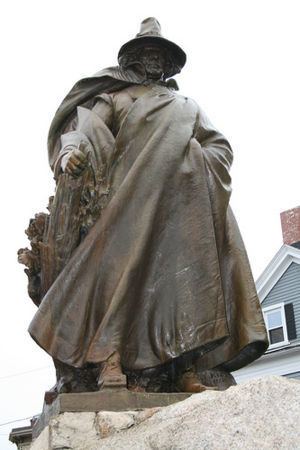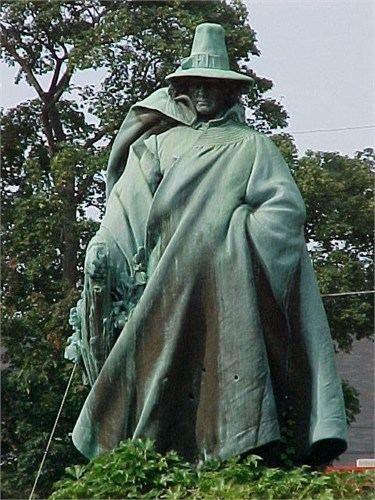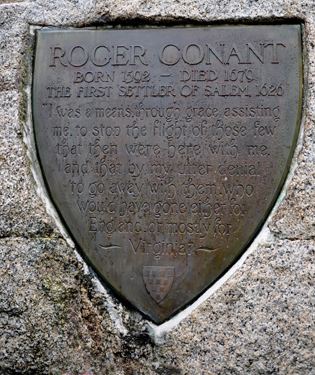Name Roger Conant | Role Colonist | |
 | ||
Died November 19, 1679, Beverly, Massachusetts, United States | ||
Roger Conant (c. 1592 – November 19, 1679) arrived in Plymouth Colony from London early in 1623/24 with the profession of salter. Early in his colonial life, he became associated with those opposed to the Puritan authorities in Plymouth and led the settlement to outlying areas, particularly in the Salem area, which he is credited with founding. He was the first governor of English settlers in Salem from 1626 to 1628.
Contents
- English origins
- Life in New England
- Later years in Salem
- Family
- Death and burial
- Statue in Salem
- References

English origins

Roger Conant was baptized at East Budleigh, Devonshire on April 9, 1592. He was the son of Richard and Agnes (Clarke) Conant. He later moved to London and became a salter.
Life in New England

Contrary to some accounts that Roger Conant and his family arrived in 1623 in the ship Anne, per Banks, only Roger's brother Christopher Conant is listed as being on the Anne in 1623. In Bradford's history, in addition to letters to him by the London Adventurers, mention is made of an unnamed master or journeyman salter who may have arrived in Plymouth in the Charity in March 1623/24. It is thought that Bradford may have been describing Conant, and that he arrived in Plymouth in 1624.

In 1625, Bradford learned that the long-time minister of their Leiden congregation, John Robinson, had died. Robinson had been the driving force behind all their efforts to find a better place than England to live their lives and it was he who cared for the many left at the Leiden congregation after the Mayflower's departure. After the dispiriting news of Robinson's death, those in Plymouth began to lose the fervor that helped them survive the grim early years there and began to fear that all they had gained might eventually be destroyed. These dark thoughts turned into mean-spirited fanaticism. At about that time, John Lyford, a minister who had been sent over by the London Adventurers, was expelled from Plymouth for secretly meeting with settlers who wished to return to the type of worship that they had back in England. One of Lyford's supporters, John Oldham, was forced to run a gauntlet while Pilgrims beat him with the butt-ends of their muskets. This punishment received the approval of Pilgrim leader Edward Winslow. The Adventurers were quite displeased over what had happened to one of their men and criticized the Pilgrims as “contentious, cruel and hard hearted, among your neighbors…”. Bradford later in his writings wrote that he thought that Lyford and Oldham deserved their punishments. These actions against the rebellion of Lyford and Oldham were possibly the reason Roger Conant left Plymouth for other locations where he would later continue to be in association with them against the Plymouth authorities.

In the years prior to and also after John Robinson's death, Plymouth Colony had lost about a quarter of its residents. They had moved to other areas of New England or went back to England, or to Virginia. Some, such as salter Roger Conant, found a place to work and worship peacefully in the fishing and trading outposts along the New England coast at Nantasket and Cape Ann.
Per Hubbard's General History, about 1624 Conant moved to Nantasket with his family and about a year or so later relocated to Cape Ann, at the north end of Massachusetts Bay.
In another case of the new Pilgrim vindictiveness, in 1625 Roger Conant was involved in a violent situation between Plymouth Colony military Captain Myles Standish and some fishermen on Cape Ann. Conant was so shocked by the violence the Plymouth captain displayed that Conant later reported the incident in detail for Pilgrim historian William Hubbard. In restating John Robinson's earlier concerns about the way the colony was turning to fanaticism and violence, Hubbard wrote, "Captain Standish…never entered the school of our Savior Christ…or, if he was ever there, had forgot his first lessons, to offer violence to no man." Hubbard also wrote about Standish; "so was the Plymouth captain, a man of very little stature, yet of a very hot and angry temper."
In 1626 Conant was chosen as the first governor of the English settlers at Salem and was replaced in 1628 by Gov. John Endicott.
Later years in Salem
Conant built the first Salem house on what is now Essex Street, opposite the Town Market. In 1630 he was chosen as freeman, or voting stockholder of the Massachusetts Bay Company. Conant was one of the first two Salem representatives to the colony's general court or legislature, and was repeatedly elected a selectman by the people of Salem. When the legislature granted communities the right to establish district courts, Roger Conant served on numerous Salem quarterly juries for sixteen years. He also was involved in civic activities over the years such as establishing town boundaries and laying out land grants.
In 1639, his signature was one of the first ones on the contract for enlarging the meeting house in Town Square for the First Church in Salem. This document remains a part of the town records at City Hall. Roger Conant was active in the affairs of Salem throughout his life.
During his very long lifetime Conant had a number of family tragedies, including the death of his wife Sarah, and of sons Caleb, Lot, Roger and Joshua. Only his son Exercise and possibly several daughters succeeded him.
Family
Roger Conant and Sarah Horton married at St. Ann Blackfriars, London on November 11, 1618 and had nine or ten children. She was alive in November 1660 and may have died before March 1677/78 as she was not named in her father's will. Her burial place is unknown.
Children of Roger and Sarah Conant:
Death and burial
Roger Conant died on November 19, 1679 in what is now the city of Beverly in Essex County, Massachusetts. He was reportedly buried in Burying Point Cemetery in Salem.
Statue in Salem
In 1913, the Conant Family Association approved an heroic bronze statue of Roger Conant in a dramatic, cloaked pose which stands today facing the Salem Common.
